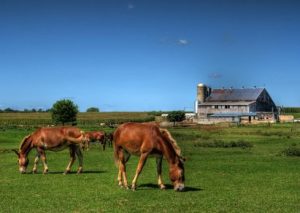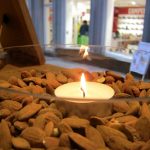 John M. Edwards arrives like gangbusters in the Pennsylvania Dutch Country, a fundamentalist locavore dreamscape straight out of the Harrison Ford flick “Witness.”
John M. Edwards arrives like gangbusters in the Pennsylvania Dutch Country, a fundamentalist locavore dreamscape straight out of the Harrison Ford flick “Witness.”
When my British friend Vicky Langdale arrived at my apartment above Tullio’s Hair Salon in Westfield, New Jersey, I began brainstorming for something different to do, and I decided on a car trip to the Pennsylvania Dutch Country.
Both of us had seen the Harrison Ford movie “Witness.” We admitted we had been more moved by the scenery than the story itself, involving people dressed in funny costumes and an ancient order almost impossible to crack. The Amish mafia, many of them in wide-brimmed hats straight out of “The Twilight Zone” (original series), helped each other with barn building, and outlawed modern appliances such as electric shavers and cable TV.
More serious was an extreme sect called the “Black Bumper Amish,” who don’t even allow the color of chrome on their horse-pulled buggies, all of which are painted black.
Anyway, we thought this would be a fun, even merry, trip.
On the way in Pennsylvania, of course, it began pouring down rain, and as if a witchcrafty warning for chasing down a buggy of freaked-out Amish all dressed in black in front of us with demonic laughter, one of my window wipers got snagged and broke off, leaving me with the nearly impossible task of wiping the window with my left hand and driving with my right hand at the same time.
I pulled over and we waited for the tempest to abate.
And soon, the sun back comfortably over our heads, we oohed and aahed at a real red barn on an expansive field of dreams, with a light rainbow, perfect for a postcard snapshot. We had arrived on the outskirts of “Intercourse, Pennsylvania” (founded in 1754 as “Cross Keys” and renamed “Intercourse” in 1814), off Route 340 and 722. Passing signs for “Hot Air Balloon Rides,” we decided not to chance it.
Traveling in the Amish country is like a guilty pleasure. In one random town I found the sight of young wide-eyed Amish innocents in costume discreetly downing vanilla shakes at Denny’s.
Finally finding a homey bed-and-breakfast—the kind that leaves mints on your pillows—we sat through a long diatribe on the history of the region from the over-helpful manager, who was not Amish but an antique collector. The only problem was that we were anxious to sightsee, and it was almost impossible to interrupt his obviously memorized
discourse.
At last, off again by car, we drove aimlessly through the American pastoral landscape, passing farms with solid barns and grain silos, in search of naughtily named towns. Here in Lancaster County, the unsuspecting tourist can actually arrive in a town called “Hell,” featuring moo cows mowing the grass on the periphery.
Most of the small villages with biblical names we navigated had antique shops, galleries, and boutiques selling souvies, as well as restaurants selling Amish food and prezzies such as German-style pretzels and hard handcrafted artisanal cheeses.
In my guidebook I was surprised to find out that the Pennsylvania Dutch were not Dutch at all but instead “Deutsche” (German). Although the “Old Order Amish” (Amish Mennonites) date back to 1720, with their wide-brimmed straw hats and white shirts and black jackets, successive waves of newbies have entered the community. Most of them moved to the remote countryside of another continent in the 1800s as religious refugees, to escape persecution and to freely practice their Christian fundamentalism away from the philistines, and making do with no machinery (the devil’s work), not even a toaster or a blender.
According to customary “Ordnung” (rules), no one in the Amish Annabaptist movement community is allowed to study beyond an eighth-grade education (13). What they can do they do well, such as jarring jellies, jams, pickles, eggs, cheese, honey, ham, sausage, and such specialties as “chicken corn soup.”
No one is allowed to vote, but they pay taxes.
Including the Amish, Mennonites, Lutherans, German Reformeds, Moravian, and other sects, the Pennsylvania Dutch Country seems cookie cut from a gingerbread fairytale Welt, one without jewelry (not even wedding rings) and Jewry (Amish are sometimes mistaken for the also-black-clad Hassidim).
William Penn’s promise of freedom did not strike tin ears, even though telephones are now banned from Amish homes (some sneak cellphones), and the rapper Vanilla Ice filmed a TV special on building with them, which none of them will ever see.
But after once again chasing down a horse and buggy with a morose-looking family dressed all in black, we realized that we were the ones who resembled space aliens in our fleecy Patagonia jackets. We had arrived in the village of Christiana, once a hub for the Underground Railroad of the Civil War, just in the nick of time, to say our prayers against thunder-and- lightning storms on the way back to the so-called Garden State.
We stopped off at an Amish eatery near the pretzel factory in Intercourse and ate “ham and noodle casserole” (a local specialty).
“So what do you think?” I asked.
Vicky picked at the icky. “I can’t wait to get back to New Jersey,” she allowed. “I’ve always wanted to see Asbury Park, where Bruce Springsteen came from. . . .” (Vicky back then worked for Chandos Records in Colchester, England.)
“They have good hotdogs there!” I enthused, with a mouthful of bracken.







Leave a Reply